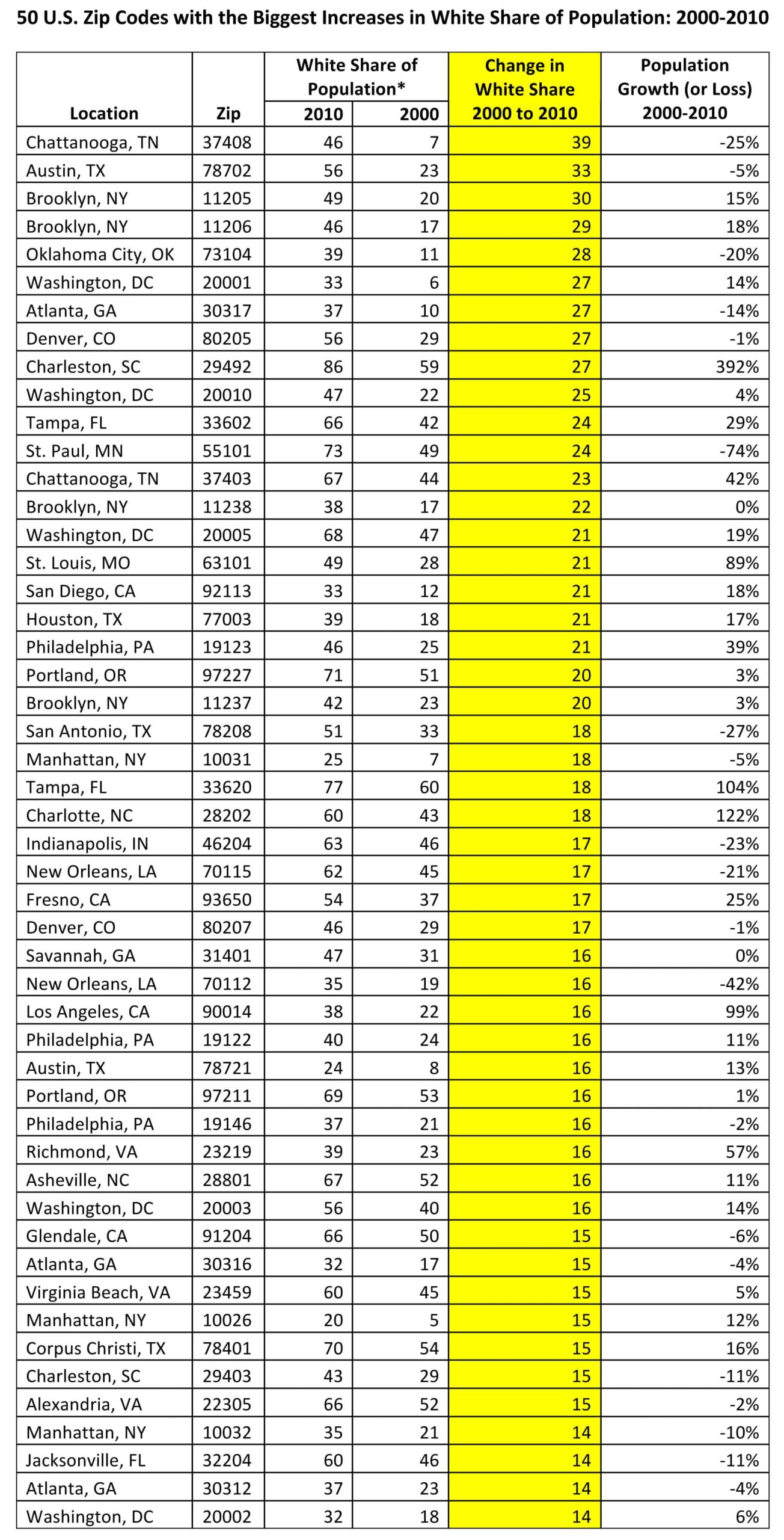The other day, I posted a list of the 25 “fastest-gentrifying” zip codes in the U.S.—a list that generated a great deal of commentary. Now I’m back with a new, improved, and expanded list; give it a look and let me know what patterns jump out at you.

* Non-Hispanic White
With the new list, I’ve tried to address several complaints that readers lodged against me (and the post), most of them fair. First, many were upset that I equated “gentrification” with a significant increase in the white share of a neighborhood’s population. In my defense, I did admit that looking at the numbers by race was far from perfect—gentrification is a socio-economic issue—but census income data by zip code are not yet available for 2010. Still, I chose to use the “gentrification” word, and it’s reasonable to point out its inaccuracy. (I didn’t even contemplate using the term “whitened”—what is this, Crest Toothpaste?—as some in the media did.)
Second, I failed to look at the population numbers for these zip codes, and as a result I included several that had tiny populations—phantom zip codes really. That included Columbia (SC)’s 29202, Chicago’s 60604, Roanoke’s 24011, and Dallas’s 75247, all of which had 2010 populations of less than 1,000. That was a rookie mistake.
So with the new list, I’ve filtered out those four tiny zip codes, and I’ve also provided an important piece of context: The percentage change in the total population from 2000 to 2010. This can help us determine whether a long-standing residential neighborhood has experienced significant demographic change (what might typically be termed gentrification or displacement) or else is home to the redevelopment of formerly empty or commercial land (what might be called urban revitalization).
Now, here’s what jumps out at me:
- Several of these zips have experienced enormous population growth. Charleston (SC)’s 29492 is the most extreme; one reader posited that this mostly rural zip code had been developed between 2000 and 2010 (and most of its newcomers are white). But zip codes in Charlotte, Tampa, St. Louis, Los Angeles, and Richmond show similar (if not as extreme) trends as well. I suspect these are places where commercial property was rezoned for residential use—and high-rise condos and the like were built during the 2000s.
- On the other hand, plenty of these zip codes show relatively stable populations from 2000 to 2010—and dramatically shifting demographics. Not surprisingly, these include places where there’s been a great deal of conflict around “gentrification” (or whatever you want to call it), as it means that lots of whites are moving in and non-whites are moving out. Good examples include Austin’s 78702, Denver’s 80205 and 80207, DC’s 20010, Brooklyn’s 11237 and 11238, Portland’s 97227, and Alexandria (VA)’s 22305.
- The zip codes that have seen a big influx of white residents and a big decrease in population are somewhat perplexing, but perhaps these are neighborhoods where big public housing complexes were torn down and replaced by upscale apartments or condos. Maybe that’s what explains Chattanooga’s 37408, Oklahoma City’s 73104, and San Antonio’s 78208. (It’s easier to explain what happened in the two New Orleans neighborhoods on the list—which not surprisingly look very different pre-Katrina and post.)
- When considering the expanded list of fifty zip codes, Gotham and Washington, D.C. maintain their dominance. Manhattan gets on the board with three zip codes (in addition to Brooklyn’s four), and two Capitol Hill neighborhoods join the NW zip codes to form the D.C. quintet. Add Philadelphia (three zips) and the Acela corridor boasts 30 percent of the neighborhoods on the list. The South is even stronger, with almost half of the 50 zip codes accounted for there.
- The Midwest, on the other hand, is mostly missing in action. Save for St. Paul’s 55101 (with a suspiciously large drop in overall population that raises questions about its data), St. Louis’s (very small) 63101, and Indianapolis’s 46204, mid-America is nowhere to be found. Gentrification-as-a-gateway-to-school-integration does not appear to be a viable option for this huge chunk of the country.
View map of increase country codes here.
– Michael Petrilli
This post originally appeared on the Fordham Institute’s Flypaper blog.


